Ellen and Jim Have a Blog, Too
We are two part-time academics. Ellen teaches in the English department and Jim in the IT program at George Mason University.


East Central 18th century conference, Georgetown (2): couplets, reformed rakes (!), & moral geography in Mansfield Park · 21 November 08
Dear Friends,
On the second day of the conference (Saturday) I slept late, and so missed a session on opera (Handel and Donizetti), a paper on Steele, one of John Home’s Douglas, and a session on Swift and Defoe I probably would have found interesting. I managed but two good sessions and I here report on a talk and a paper: the plenary lecture at 1:30 pm by J. Paul Hunter, “Learning to Love Couplets;” and another session (at 3:15 pm) of “The Politics of the Canon,” where there was to be a paper on Richardson’s Clarissa, which was of genuine interest to me. I also report on the Austen session on Sunday.
Prof Hunter showed one can talk on a common important topic in a genuinely interesting and fresh way and provide stimulation and fresh insights in the plainest of language, without pomposity or exaggerating one’s findings. The hegemony of the couplet from 1590 to the 1790s, and of the heroic couplet to 18th century verse is self-evident. Iambic pentameter couplets were used for every subject and every kind of genre (including plays). I’ve had the experience a couple of times of someone asking me how can I like 18th century literature when central to its poetry is this rigid form with its obtrusive rhymes. Essentially Prof Hunter set out to explain the nature of the couplet form, what’s difficult about them, and how has learned to like them.
First he admitted that heroic couples are not easy to love. They are too intellectual: they are clever, showy, glib, something learned, a constrained form. They are nowadays often regarded as a curiosity to be explored historically and the attitude is one of suspicion, hostility and mild amusement. Yet they have had a long and obtrusive history in French and English. The French form differs because of the grammatical structure and rhythms of the French language; the couplet is 12 feet long. There have been major figures who attacked or at least did not use the couplet: Campion, Milton (and all his various followers), in the 18th century Dennis and the Whartons. He seemed to think the popularity of the form stemmed from the widespread use of the sonnet in the 1590s.
He then went on to characterize them. They workout of a sense of binaries: twoness is at the heart of the couplet. The lines are pitted against one another, and the each often falls into two parts: the medial pause is central to many, where one part is pitted against the other too. A continual criss-cross of wittiness binds them; within these matched pairs, adjectives seep into nouns and nouns into adjectives, verbs turn the nouns into puns and vice versa. He seemed to feel the unit is not the single line, but a verse paragraph, the tower. They are meant to build up. You can slip in lines as you please later on; you can play with the form through triplets, by (in English) using hexameter and enjambment. The effect is a highly aesthetic continually intensely twistingly contextualized texture where a lot depends on small particulars.
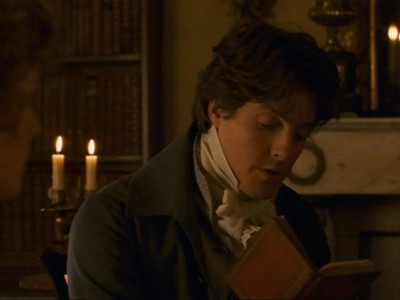
Edward (Hugh Grant) reading aloud Cowper (‘95 Miramax S&S)
Prof Hunter then said he thought the couplet has lost its hold on readers because it demands hard reading. You have to engage with the craft or art itself. In the 19th century reading spread to include a wide range of readers who could or would not engage in this sort of study, and poets to attract them had to write to please. This part of his talk picked up on a subject we had recently discussed on Eighteen Century Worlds at Yahoo when after I read Nick’s blog, we discussed different kinds of reading. The book I found most useful for this kind of differentiation is Robert DeMaria’s Samuel Johnson and the Life of Reading where DeMaria distinguishes 4 kinds of reading: two are intense and active, study and perusal; two are relaxed and superficial, passive and curious reading. The last means you stroll through, dipping, skimming. Well, couplets demand intense and active study and perusal for real enjoyment of them.
The question and answer period after his lecture elicited from him further candid and useful comments. For example, he agreed that the gender of the writer affects the kinds of couplets written. Women chose different subjects; they often do write in different moods from men; their particular vocabularies or the language register alters. He did not think non-dramatic poetry was read aloud in the 18th century, but that it was expected to be perused quietly, with the reader imagining the tones and voices.
For my part I disagree with one of his assertions and am not sure about the other. I think the unit of the couplet is the single line as I think the unit of all poetry is. I am not sure that poetry was not read aloud in the era: think of the prologues and epilogues of the many plays and how well the best poetry sounds when it is read aloud. Prof Hunter brought with him passages from Pope and Swift, as well as the whole of Anne Finch’s “A Nocturnal Reverie” and all of these read aloud beautifully—as also did Pope’s Rape of the Lock which a group of us had read aloud the night before. Quintessential epigrammatic couplets speak out at you:
I am his highness’ dog at Kew,
Pray tell me, sir, whose dog are you?
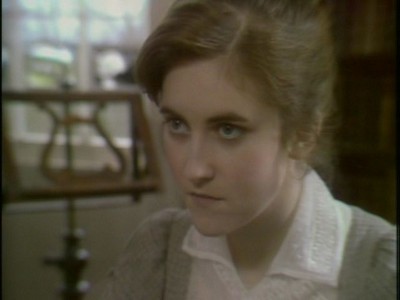
Fanny (Sylvestre Le Tousel) listening to Edmund read aloud (‘83 BBC MP)
*****************
Joanne Roby, a graduate student, gave away the underlying premise or impulse for her paper, “Richardson’s Lovelace: A Rake on the Loose or Reform Gone Bad?” when she admitted that she is attracted to Lovelace. Her argument took off from critics like Warner who emphasize that Lovelace shows a capacity for reform. She wanted to show that Richardson failed to prove his basic contention that a reformed rake cannot possibly make a good husband. She argued that rakes in the novels are not imagined as completely outside the possibility of real change or reform. Obviously Belford reforms.
What was appealing about her paper was she went fully into Lovelace’s breakdown at Clarissa’s death: she quoted him to show he was receptive to feeling, and could have been a man of sensibility; she found his hysteria rooted in a melancholy that she made attractively connected to remorse. Lovelace has become mentally ill by the end of the novel; he wants to own Clarissa body and soul, has lost all power over himself and her by the end. She seemed to feel this closing state recuperated him on some level, partly because it showed his emotionalism and dependence on Clarissa. It seemed to me the speaker showed sympathy towards states of real emtional distress and by extension mental illness (brought on partly by cultural conditioning and social experience, e.g., the whores mock Lovelace for being insufficiently quickly vicious).
A couple of people presented objections; others made suggestions for improving her argument by changing her terms like hysteria. I suggested to her that for Richardson what someone did mattered, and that no emotional state after a deed would be seen as retrieving the deed, and that after the rape Lovelace reverted to his hardened point of view each time he thought (though she never did) Clarissa yielded to him ever so little. I thought her argument would be more convincing if she concentrated on Belford who did reform slowly and stayed reformed based on principles and altruism.
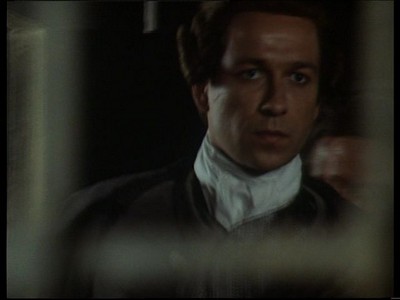
Jack Belford (Sean Pertwee) watching Clarissa through a barred prison window (‘91 Clarissa, towards the close)
I admitted that I am not now attracted to Lovelace and think that this attraction to Lovelace is precisely what Richardson wanted the reader to see as meretricious, but liked seeing how he had a nature which included terrains central to Clarissa’s own: a deep complicated rich interiority, sensibility, emotional attachment. Nonetheless, while he may be emotional about his own needs, when it comes to other people—and especially women—he can be coldly manipulative, an ultimate liar. Since in life I have encountered so much hypocrisy, and before I married for the 2nd time, male aggression, I find this portrait believable and it makes me remember how dangerous life is.
The other three papers of this session were one on James Thomson’s patriotic history plays (infused with pathos, and showing how difficult it is to enact public virtue), one on Smollett’s Peregrine Pickle (showing the beginning of policing as a way to control individuals in society, and how recent financial lending games were used in the 18th century) and one on Fielding’s Tom Jones (as a politically progressive novel). This session was typical of the conference in that no critique of the norms underlying say this policing and attitudes towards human relationships underlying debt & credit scheming was attempted.
I was though troubled to discover that today someone has been influenced by graduate education to ignore the proto- feminism of Richardson’s book. It is what makes his book important and living still. A new book, Rape, Sexu, Violence, History by Joanne Bourke, shows us that we live in a culture today where rape is a logical result of coercive sexual relationships. Rape is overlooked and even encouraged by our customs and interpretations of laws still. We have in Lovelace the depiction of someone whose creed it is to humiliate and degrade a woman as a test of her character. There is a direct connection between violent sex and killing. In the filmic version of the novel by Janet Barron and David Nokes, a presentation meant to speak to the public on terms it understands, the Harlowe brother and sister harrow Clarissa sexually as a way of bending her to whatever use they want to make of her. Life as manipulation and performance is shown to be central to this society. Anna’s distrust of Hickman and evasion of her mother’s bullying becomes a natural self-protective response.
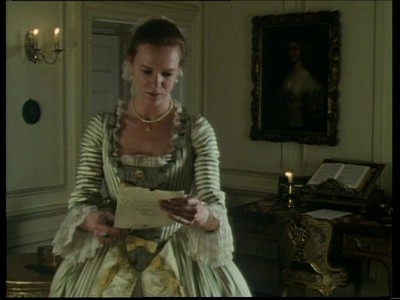
We see Anna Howe (Hermione Norris) reading in a harassed state; she has to close the door in order to find some peaceful space to allow her friend to reach her (‘91 BBC Clarissa)
I had gotten to talk to friends before and after the lecture, and those Richardsonians at the conference who were there attended the same session I did. While waiting for the session to begin, we did talk with a couple of people about opera. I was not aware how many modern operas there are, how many written today based on today’s novels and plays. One woman friend said she travels about just to see and hear these. One problem with them is (as in film adapations) the demand for literal fidelity skews what is dramatized and often they end up having many short scenes in order to get in all the crucial events and characters of an original source text.
I was sorry not to stay for another session; there was a paper on Burney’s Evelina, papers on travel literature, on Voltaire (“Desolation beyond the Pyrenees” about Spain as a “Land of Darkness”), but I wanted to go home to practice showing clips and stills while giving a paper some more. So after this session, the Admiral and I walked back to our car through a beautiful autumnal afternoon: a bright blue sky, variegated colored leaves, cool misty air. I did indeed practice my paper a couple more times. Then we had a good supper with Yvette, drank wine, went for a walk in the evening. And so to bed.
*****************
Sunday there were two session on at 9:00 and my paper was to be given in one of these, “Re-evaluating Austen.” We arrived early so that Jim could fix the equipment and make sure I would be able to show my clips and stills properly. Alas, the woman running the conference had not done her job and there was no one available to help us throw our images onto the larger screen, and I had to use my laptop as a screen. However, the room was not large, and the crowd not that big so people came more to the center of the room, and apparently they saw and heard enough to make my paper make enjoyable sense.
When I say not that big, I have to qualify: a lot of people came! The room felt filled; all the rows of chairs were nearly taken. Beth Lambert, who was chairperson expressed surprize as did my co-speaker, Manuel Schonhorn; Austen draws people, and I recognized a number of Austenites. I am pleased to say I also saw a couple of my friends came to hear me speak too. I have already gone over my “The Gothic Northanger Abbey”, and (as I wrote later that Sunday), it’s now in my new An Austen Miscellany.
There remains to give some sense of the two lucid suggestive papers my colleagues gave. Beth Lambert’s “Raising Demons: Chidren in Austen’s Novels,” was about how Austen used children in S&S, P&P and MP to reveal the moral and intellectual deficiences of those around them, especially their mothers. Bad children in Austen are shown to be the product of unintelligent indulgent upbringing. Beth also showed that with such children around, Austen shows how genuine conversation, adult enjoyment and individual fulfillment for those around them is wholly prevented. We agreed afterwards that Austen evinces an unforgiving view of commonplace less than admirable (but not actually evil) traits of people.
Manuel Schonhorn’s “Sites of Value: geographical and social places in Mansfield Park was one of the most original papers I’ve heard on Austen’s novels since I started going to conferences. Prof Schonhorn showed the cartography and geography of MP reveals its ethical dichotomy. On the one side are the book’s rare good places where beautiful relationships, things, emotions can flourish: Fanny’s attic room, which (like the song in Sondheim’s Sunday in the Park with George which describes how the artist made his picture), she gradually painfullly put together from small left-over precious sites of memory; the church upstairs at Sotherton; the house the Crawfords live in which Fanny and Edmund will eventually occupy. On the other, are bad places where coldness, cruelty, exploitation, betrayal, humiliation occur: this includes many of the downstairs rooms, including the billiard room, in Mansfield Park, Antigua & the West Indies, London, the landscape around Sotherton (where cottages and oak trees are at risk from the whims of the owners).
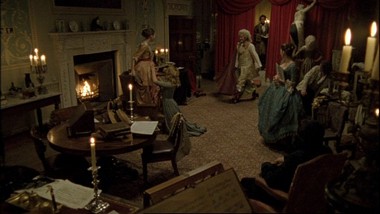
Acting out Lovers Vows (‘07 ITV MP)
Prof Schonhorn showed how Austen used the designation “east” to characterize places which have to be worked at to make them humane, comfortable decent; Crawford wants to make Edmund’s rectory front turned to the east. “West” was a more positive designation. He showed her also using the word “up” and “down” and “north and south” to make an interior ethical map which matches the very detailed map of England itself which we have in the novel. Admittedly these designations are not consistent through the book, but he did pay close attention to the text of MP as well as its structuring of symbolic places and realistic detail. Perhaps had he made a multivalent scheme instead of a dichotomous one he would have not had problems with his map.
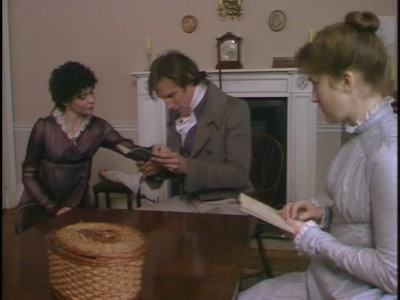
Fanny (Sylvestre Le Tousel) watching Mary Crawford (Jackie Smith-Wood) and Edmund (Nicholas Farrell) reading aloud Lovers’ Vows (‘83 BBC MP)
The beauty of the wide-ranging thesis is it shows how the Trilling point of view which sees Mansfield Park as the great good place, and the amoral readings of Fanny Price are wrong without resorting to imposing post-colonial readings onto the novel. He did not over-emphasize the importance of slavery and Antigua and yet revealed that the horrors of what went on in the West Indies at the time fit into a larger scheme literally in the book. The book’s richly detailed cartography and geography gives insight into how to read the book so that Antigua, the West Indies and slavery become one of many points of reference. I felt I had been made to see things in the novel I had not seen before but were there all the time.
The discussion afterwards was really lively. I rejoice to say Yvette came with us, and heard all three papers. She clearly understood them, and participated in the discussion. What was said was right on her wavelength: she instanced how the east and west winds are used in Mary Poppins and spoke a second time too. People spoke to her before the session and during. Lots of questions to me about the Austen movies. We ranged over whether MP is a book different from Austen’s other famous 5 to her limitations as an artist and the reflections of her life in the books. Happily there were no fans to object to genuine evaluative statements; there was no defensiveness when Austen’s narrownesses were pointed out.
This last session not only made our day; it has heartened me about the coming ASECS where I’m to give a Clarissa paper. I see how important it is to be easy to understand, relevant for your audience, and stay within the time limits—as well as read the paper aloud well (basically that means slowly). And I’m thinking to myself it must be fun to go to a JASNA where there will be so many people passionate about Austen, many of whom know her work well and are intelligent. So a few days later I made the decision not to ask for summer courses and will either work on a paper for JASNA (“Disquieting Patterns in Austen’s Novels”) which I’ll try to make appealing to the audience or on my much dreamt-of and worked on book, The Austen Films.
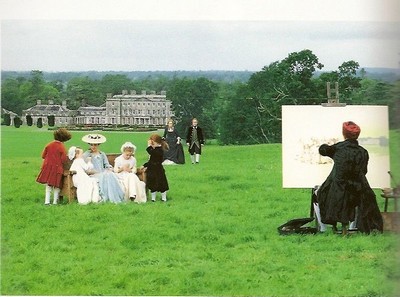
A conversation piece from Harriet O’Carroll’s Aristocrats
Ellen
--
Posted by: Ellen
* * *
Comment
- I enjoyed reading your blogs about the conference, Ellen – it sounds as if you had a good time and fitted in a lot. I’d love to have heard your paper.:)
I do like heroic couplets, although I sometimes find it hard to take in long passages which are written in that form. I’m not sure when couplets are heroic – I recently read ‘Auguries of Innocence’ by Blake with the great couplet, which seems relevant to our discussion of the French revolution, ‘Some are born to sweet delight/Some are born to endless night’, but I’m not sure if these couplets count as heroic with the slightly shorter lines?
On ‘Clarissa’, I remember wondering if Richardson was brooding over how he has presented a reformed rake as an ideal husband in ‘Pamela’ and rewriting the same story another way round, going far deeper. It seems as if he is worrying about this question in ‘Pamela 2’, where there is some discussion about how a reformed rake may not always be a good husband after all, and then in ‘Clarissa’ we have the rake who won’t reform. It’s a few years now since I read ‘Clarissa’ and of course I don’t know it nearly as well as you do, but I remember feeling as if Richardson makes Lovelace as attractive and seductive as possible, pouring so much wit and brilliance into his letters, but then shows that any readers being seduced are wrong to be dazzled. I am interested in the question of whether he is “unfair” to Lovelace at points in the novel – I’d been thinking about this when watching the adaptation of ‘The Tenant of Wildfell Hall, where it’s impossible to sympathise with Arthur Huntingdon, and yet I find I can’t sympathise with Helen’s puritanical views either. My feeling is that Richardson probably gives Lovelace a much “fairer” show than Anne Bronte does to Huntingdon, although it’s a long time since I’ve read that novel. I can sometimes find these glamorous, self-destructive rakes quite attractive on the page, or in a movie, but am aware I would turn away in real life.
Hope all this makes sense. I’m finding myself tempted to reread ‘Clarissa’ after all, you know, Ellen.
PS I love that still of Hugh Grant as Edward.
— Judy Nov 22, 11:49am # - Judy has two rich paragraphs here. Let me answer the first this morning.
Yes I neglected to address the fundamental question, how is a heroic couplet different from other couplets? Basically, they are much much tighter: they are 10 feet, or iambic pentameter (when they are 12 on rare occasions the poet is teasing); they rhyme strongly, they have a strong medial pause, and they tend to have much antithesis inside the lines which both reinforce and undercut the meaning. The quintessential ones are epigrammatic (as in the quoted lines by Pope: “I am his highness’ dog …”) See also Finch's couplet from “A Noctural Reverie:”
When in some River, overhung with Green,
The waving Moon and trembling Leaves are seen;
and compare it with Pope’s imitation in “Windsor Forest”
In the clear azure gleam the flocks are seen
And floating forests paint the waves with green.
My view is they first emerge in the Restoration and are called heroic couplets because Dryden developed the particular variant of the form in the heroic drama. He managed to write these couplets in a way that was forward thrusting too, so that the form assumes a verse paragraph as a development; and he used them to depict action and psychology (very rough or general as Dryden in his heroic dramas is not exactly subtle). They are brought to an exquisite development by Pope.
Having said, that they include many variants which move away from this tight form, and it’s a matter of taste or judgement whether you call more relaxed versions of this type of couplet heroic or non-heroic. I’d say Goldsmith in “The Deserted Village” is still writing heroic couplets; Johnson uses the form in “The Vanity of Human Wishes." The definition excludes poems by Swift where he has rhyming pairs of 8 syllables (so a sonnet must be 14 lines even if Meredith did 15 line ones).
I feel Crabbe, though, is really moving away from this, particularly in his later tales as the lines begin to move forward, are not artificial in feel and become more and more narrative. Yet they still have lingering aspects of the form which enrich individual lines.
J. Paul Hunter also wrote a respected and still often quoted essay on “The ideology of the couplet” where he argued that underlying this poetics is a conservative viewpoint. Certainly many of those who wrote in this form were conservative; it does not have to go with the territory of satire (remember Voltaire), ECent, 37:3 (1997):257-70. As he said in the after period of the discussion, women write the heroic couplet somewhat differently since they are sociologized to present themselves differently, are pushed into different life experiences, and have different topics often.
E.M.
— Elinor Nov 23, 8:02am # - From Kathy:
"I enjoyed your blog on the 18th century conference and, as usual, you make me want to read obscure writers whom I know nothing of. Your versatility amazes me."
— Elinor Nov 24, 12:17pm # - Many thanks for the explanation of heroic couplets, Ellen – much appreciated. I see the Blake couplet I quoted isn’t heroic because it is shorter, although still striking. I love the comparison between the lines you quote from Finch and Pope.
— Judy Nov 24, 12:53pm # - Dear Judy,
One of the significant or defining beauties of the heroic couplet is that the parts of the lines bleed into one another. Most of the time, this is shown by analyzing how satiric or ironic puns on one side of the couplet apply to the analogous puns on the other; how a verb meant for one noun ironically belongs to another and changes its meaning (with a satiric thrust); how the second line does this to the first, and vice versa.
It's harder to show is how descriptive & emotional verses also bleed into one another so that the meanings and pictures of the words reshape one another’s color and meaning -- though the eye observes this as in the famous paragraphs on the sylphs in The Rape of the Lock. In his imitation of Finch, Pope is showing off: he has improved on or intensified Finch by getting more meaning and colors in (green and blue) by making his individual words more complex latinate, & his syntax much tighter, so there is more to bleed back and forth. In hers we only see the moon and trembling leaves (as the water trembles) in the river (thus green is seen there too); in his white flocks become azure and are in the river as well as whole floating green forests which are also blue.
We can see this bleeding in descriptive verse especially richly in Pope's early masterpieces, e.g., "Rape of the Lock," "Eloisa to Abelard," and for example, a 2nd line from one couplet & the 2 lines which also come from Pope's Windsor Forest:
When frosts have whiten'd all the naked groves;
Where doves in flocks the leafless trees o'ershade,
And lonely woodcocks haunt the wat'ry glade.
Ellen
— Elinor Nov 25, 6:16pm #
commenting closed for this article
